A3 Tutorial Slides
- 1. The A3 method for the Introduction of Business Process Support Systems in Operational Practice Ilia Bider, IbisSoft & Stockholm University & Paul Johannesson, Stockholm University with the help of Erik Perjons, Stockholm University Prepared for BPM 2010: http://www.bpm2010.org/
- 2. Introduction Introduction of a new BPS system in an organization is difficult Having a good system is no guarantee BPS system usually requires changes in the ways of working and communication between people. What to do when an introduction processes went not exactly according to the plan? A3-method was especially designed to answer this question as it can be applied at any point of an introduction process A3 is a pragmatic approach. It came from practice, but has theoretical grounds Let's reinvent it !
- 3. Consider a situation A BPS system is installed in your organization The system is good enough for the intended purpose People do not use the system or only only partly use it We can restart the introduction process from the beginning What shall we do? 5 min brainstorming
- 4. Separate assessment of the situation from the history How to express results without mentioning history ?
- 5. Parameters Parameter – something that can be measured One (final) parameter is System use Can we suggest other parameters to assess a situation? 10 min brainstorming Parameter: System use Parameter: Parameter: Parameter:
- 6. Our solution: parameters in A3 Organisational culture Previous experiences of changes Alignment system and organisation Strategic understanding WHY Tactical understanding WHEN Operational understanding HOW Attitude and motivation System use
- 7. Wh ich relations exist between the parameters? System use Brainstorming for 5 minutes Organisational culture Previous experiences of changes Alignment system and organisation Strategic understanding WHY Tactical understanding WHEN Operational understanding HOW Attitude and motivation
- 8. Parameter relations in A3
- 9. Brainstorming in groups for 15 minutes Each group shall develop questions for interviews/questionnaires measuring 1-2 parameters How to measure parameters?
- 10. Strategic understanding Questions to be posed to the end user: In your opinion, what is the purpose of the system? (This question might have a fixed set of alternative answers listing possible purposes, or request an answer in natural language.) What do you gain from using the system when doing your tasks? (Requires an answer in natural language) What does the organisation gain from the usage of the system? (Requires an answer in natural language)
- 11. Tactical understanding Questions to be posed to the end user: In which of the following situations should you use the system? (Question with a fixed set of alternative answers, where the alternatives consist of relevant as well as irrelevant situations. If alternative answers are to be provided, they need to be tailored to the specific organisation and system) Do you know what information you should enter into the system in the work situations when you are supposed to use the system? (Question with a fixed set of alternative answers) [ ] Yes [ ] Not always [ ] No
- 12. Operational understanding Questions to be posed to the end user: How often do you experience uncertainty about how to work in the system? [ ] Always [ ] Often [ ] Seldom [ ] Never How often do you ask for help with operating the system? (Question with a fixed set of alternative answers) [ ] Often [ ] Seldom [ ] Never
- 13. Alignment between system and organization Questions posed to the end user: Are the terms used in the system the same as those used in the business? [ ] Yes, most of the terms in the system are used in the business [ ] No, several terms used in the system differ from those used in the business [ ] No, most terms used in the system differ from those used in the business When the system requires you to categorise or to make a choice, are the alternatives provided understandable and relevant for your task? [ ] Yes, always [ ] Yes, often [ ] No, seldom [ ] No, never
- 14. Alignment between system and organization Questions posed to the end user: When you use the system do you find all the information that you need for you specific tasks that is supposed to be inputted by others? [ ] Yes [ ] Yes, to some extent [ ] No
- 15. Previous experience of changes For each previous reorganisation/IT introduction, the following questions (which all require answers in natural language) are to be posed to end-users who were affected by the reorganisation/IT introduction: What was the purpose behind the reorganisation/ the introduction of the IT system? What were the results of the reorganisation/ introduction, specifically: – were the desired results attained? – what were the positive consequences? – what were the negative consequences?
- 16. Organizational Culture A question to be posed to management : Are your subordinates used to being ordered to carry out tasks without being informed about their reason? [ ] Yes, most orders to subordinates are given without explanations [ ] Yes, some orders to subordinates are given without explanations [ ] No A question to be posed to end-users : Are you used to receiving orders to carry out tasks without being informed about their reason? [ ] Yes, most orders are given without explanations [ ] Yes, some orders are given without explanations [ ] No
- 17. System use Questions to be posed to end-users are: How often do you use the system? [ ] Every day [ ] Three days a week or more [ ] One or two days a week [ ] Less than one day a week For which of the following tasks do you use the system? (Question with a fixed set of alternative answers, where the alternatives consist of relevant as well as irrelevant tasks. These alternatives need to be tailored to the specific organisation and system)
- 18. Attitude and motivation Questions to be posed to end-users: Would you use the system if nobody in management demand that you use it? [ ] Yes [ ] Yes if others use it [ ] No If the answer is yes there is no need to investigate the parameter further.
- 19. Individual reactions Performance expectancy. Performance expectancy means: “the degree to which an individual believes that using the system will help him or her to attain gains in job performance” (Venkatesh et al., 2003). Effort expectancy. Effort expectancy means: “the degree of ease associated with the use of the system” (Venkatesh et al., 2003). Social influence. Social influence means: “the degree to which an individual perceives that ‘important others’ believe he or she should use the new system” (Venkatesh et al., 2003). Facilitated conditions . Facilitated conditions means: “the degree to which individual believes that an organisational and technical infrastructure exists to support the use of the system” (Venkatesh et al., 2003).
- 20. How to change the values of parameters? Brainstorming for 5 minutes
- 21. Categories of means of control
- 22. Which means of control ? Brainstorming in groups for 15 minutes. Each group develops means of control for 1-2 parameters
- 23. The A3 model
- 24. The A3 method
- 25. Practical background Real life case Type of organisation Type of system Type of problems
- 26. Type of organization Non-for-profit (interest) organization Association of tenants in West region of Sweden Central office – about 60-70 employees Democratic type (achieve concensus) with a strong CEO
- 27. Type of system – BPS system based on the collaborative planning Structure of the process case/instance
- 28. Type of system - continuing Plans for a particular user
- 29. Type of problems General – 'It might be a good system, but I do not understand what shall I use it for?' Collaborative planning – not intuitive New processes (customer feedback) Previously totally ad-hoc processes (lobbying)
- 30. Theoretical background State-oriented view of business processes Kotter’s [1996] eight stages for change management Sharma and Yetton [2003] Technology Acceptance Model (TAM) The Unified Theory of Acceptance and Use of Technology (U TAUT)
- 31. State-oriented view on business processes For each item Ordered = Delivered To pay = Total + Freight + Tax Ordered > Delivered shipment To pay > Invoiced invoicing Invoiced = To pay Paid = Invoiced
- 32. Kotter’s eight stages for change management 1. Esta-bilishing a sence of urgency 2. Crea-ting the guiding coali-tion 3. Devel-oping a vision and strategy 4. Com-munica-ting a vision and strategy 5. Em- powering broad-based action 6. Gen-erating short-term wins 7. Consoli-dating gains and producing more change 8. Anchor-ing new approach-es in the culture Kotter’s eight staged for change management: A3 model:
- 33. Sharma and Yetton A3 model: Sharma and Yetton: 1. Instituting new structures 2. Instituting new performance control systems 3. Instituting new coordination mechanisms 4. Instituting changes to performance goals
- 34. Technology Acceptance Model (TAM) Two types of individual reactions influencing the use of system: - perceived usefulness , defined “as the degree to which a person believes that using a particular system would enhance his or her job performance”, and - perceived easy-of-use , defined as “the degree to which a person believes that using a particular system would be free from effort” A3 model:
- 35. U TAUT – an extended TAM Four types of individual reactions influencing the use of system: Performance expectancy. Performance expectancy means: “the degree to which an individual believes that using the system will help him or her to attain gains in job performance” (Venkatesh et al., 2003). Effort expectancy. Effort expectancy means: “the degree of ease associated with the use of the system” (Venkatesh et al., 2003). Social influence . Social influence means: “the degree to which an individual perceives that ‘important others’ believe he or she should use the new system” (Venkatesh et al., 2003). Facilitated conditions . Facilitated conditions means: “the degree to which individual believes that an organisational and technical infrastructure exists to support the use of the system” (Venkatesh et al., 2003). A3 model:
- 36. Thank you for your attention ! Corresponding author: Ilia Bider , IbisSoft www.ibissoft.se/en Email: [email protected] Additional resources: http://processplatsen.ibissoft.se/en/node/27



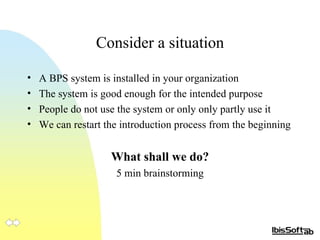




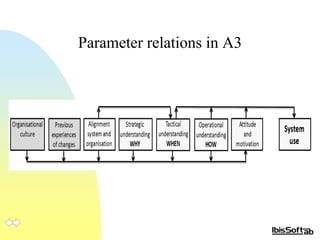
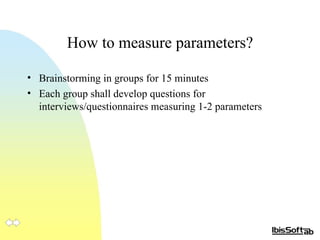
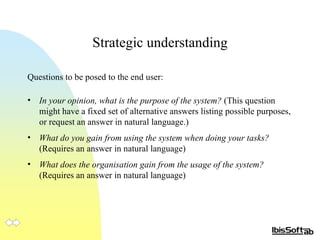
![Tactical understanding Questions to be posed to the end user: In which of the following situations should you use the system? (Question with a fixed set of alternative answers, where the alternatives consist of relevant as well as irrelevant situations. If alternative answers are to be provided, they need to be tailored to the specific organisation and system) Do you know what information you should enter into the system in the work situations when you are supposed to use the system? (Question with a fixed set of alternative answers) [ ] Yes [ ] Not always [ ] No](https://image.slidesharecdn.com/a3tutorialslides-12851606957831-phpapp01/85/A3-Tutorial-Slides-11-320.jpg)
![Operational understanding Questions to be posed to the end user: How often do you experience uncertainty about how to work in the system? [ ] Always [ ] Often [ ] Seldom [ ] Never How often do you ask for help with operating the system? (Question with a fixed set of alternative answers) [ ] Often [ ] Seldom [ ] Never](https://image.slidesharecdn.com/a3tutorialslides-12851606957831-phpapp01/85/A3-Tutorial-Slides-12-320.jpg)
![Alignment between system and organization Questions posed to the end user: Are the terms used in the system the same as those used in the business? [ ] Yes, most of the terms in the system are used in the business [ ] No, several terms used in the system differ from those used in the business [ ] No, most terms used in the system differ from those used in the business When the system requires you to categorise or to make a choice, are the alternatives provided understandable and relevant for your task? [ ] Yes, always [ ] Yes, often [ ] No, seldom [ ] No, never](https://image.slidesharecdn.com/a3tutorialslides-12851606957831-phpapp01/85/A3-Tutorial-Slides-13-320.jpg)
![Alignment between system and organization Questions posed to the end user: When you use the system do you find all the information that you need for you specific tasks that is supposed to be inputted by others? [ ] Yes [ ] Yes, to some extent [ ] No](https://image.slidesharecdn.com/a3tutorialslides-12851606957831-phpapp01/85/A3-Tutorial-Slides-14-320.jpg)

![Organizational Culture A question to be posed to management : Are your subordinates used to being ordered to carry out tasks without being informed about their reason? [ ] Yes, most orders to subordinates are given without explanations [ ] Yes, some orders to subordinates are given without explanations [ ] No A question to be posed to end-users : Are you used to receiving orders to carry out tasks without being informed about their reason? [ ] Yes, most orders are given without explanations [ ] Yes, some orders are given without explanations [ ] No](https://image.slidesharecdn.com/a3tutorialslides-12851606957831-phpapp01/85/A3-Tutorial-Slides-16-320.jpg)
![System use Questions to be posed to end-users are: How often do you use the system? [ ] Every day [ ] Three days a week or more [ ] One or two days a week [ ] Less than one day a week For which of the following tasks do you use the system? (Question with a fixed set of alternative answers, where the alternatives consist of relevant as well as irrelevant tasks. These alternatives need to be tailored to the specific organisation and system)](https://image.slidesharecdn.com/a3tutorialslides-12851606957831-phpapp01/85/A3-Tutorial-Slides-17-320.jpg)
![Attitude and motivation Questions to be posed to end-users: Would you use the system if nobody in management demand that you use it? [ ] Yes [ ] Yes if others use it [ ] No If the answer is yes there is no need to investigate the parameter further.](https://image.slidesharecdn.com/a3tutorialslides-12851606957831-phpapp01/85/A3-Tutorial-Slides-18-320.jpg)


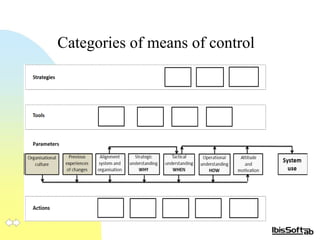




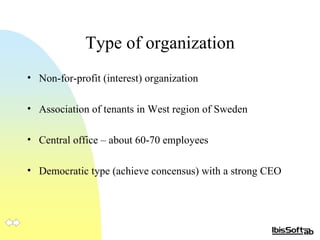



![Theoretical background State-oriented view of business processes Kotter’s [1996] eight stages for change management Sharma and Yetton [2003] Technology Acceptance Model (TAM) The Unified Theory of Acceptance and Use of Technology (U TAUT)](https://image.slidesharecdn.com/a3tutorialslides-12851606957831-phpapp01/85/A3-Tutorial-Slides-30-320.jpg)





